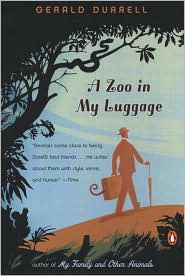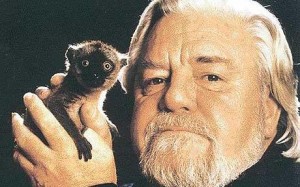“The black-footed mongoose, although still only a baby, measured some two feet in length and stood about eight inches in height…Her body, head, and tail were a rich, creamy white, while her slender legs were a rich brown that was almost black. She was sleek, sinuous, and svelte, and reminded me of a creamy-skinned Parisienne “belle-amie” clad in nothing more than two pairs of black silk stockings.”
Naturalist/write r Gerald Durrell, with a writer’s eye for the odd detail, a great sense of humor and absurdity, and an unquenchable enthusiasm for finding unusual animals and telling stories about them, recounts his third animal-collecting trip to the Cameroons in this 1960 memoir. Recently reprinted by Penguin Books, the book is a classic of nature-writing, filled with humorous anecdotes about the animals, the discoveries made about them, and, especially, about the people whose interactions with them often led to hilarious escapades.
r Gerald Durrell, with a writer’s eye for the odd detail, a great sense of humor and absurdity, and an unquenchable enthusiasm for finding unusual animals and telling stories about them, recounts his third animal-collecting trip to the Cameroons in this 1960 memoir. Recently reprinted by Penguin Books, the book is a classic of nature-writing, filled with humorous anecdotes about the animals, the discoveries made about them, and, especially, about the people whose interactions with them often led to hilarious escapades.
Durrell had made many trips over the years to all parts of the world collecting animals for zoos, but he had always found it difficult to part with the animals on which he had lavished so much care and attention. On this trip he intended to collect animals for his own zoo, one which would be open to the public and which would become a “self-supporting laboratory” so that he could continue studying them. He believed that the encroaching human population and the disappearance of native habitats endangered so many animals that extinction would be inevitable for many species unless they could be rescued and bred in captivity, such as in his planned zoo. Durrell describes his project this way: “Any normal person smitten with such an ambition would have got the zoo first and the animals next. But throughout my life I have rarely if ever achieved what I wanted by tackling it in a logical fashion. So, naturally, I went and got the animals first and then set about the task of finding my zoo.”

Arriving on the west coast of Cameroon, Durrell soon begins to collect, acquiring an extremely rare black-footed mongoose, followed by a squirrel, a bush baby, and two monkeys—all within twenty-four hours. Using pidgin to converse with the Africans, Durrell refers to all animals as “beef,” and he soon acquires many more rare animals from the local population, which remembers him from previous trips. A frightening canoe ride through hippo-infested waters, an attempt to capture a fifteen-foot long python inside a narrow cave, a search for the blue-scalped, bald-headed Picanthartes bird, and the challenging experience of smoking out a hollow tree (and acquiring paper-thin whip scorpions in the process) keep Durrell and his staff energized and excited before they head deeper into Cameroon and into the highlands.
In the highlands, Durrell has arranged to stay with the Fon of Bafut, a elderly king he had met on a previous trip, but whom he had not depicted very favorably in a previous book (commenting on the king’s enormous taste for and consumption of western alcoholic beverages). Fortunately, the Fon graciously welcomes them back on this return trip, and soon Durrell, his wife, and staff, are settled into the rural compound of the Fon of Bafut and his many wives. Durrell eventually joins the charming Fon in many long evenings filled with talk, dance, and alcohol, but ultimately he learns as much about life from the kin g as the king learns from Durrell and his animals. Soon the Fon’s compound fills up with hundreds more captive reptiles, birds, and animals, including seventeen monkeys, one of which is a half-grown baboon. Eventually, Minnie, a five-year-old chimp and Cholmondely, a baby chimp, join the “family,” providing innumerable adventures, and often great hilarity.
g as the king learns from Durrell and his animals. Soon the Fon’s compound fills up with hundreds more captive reptiles, birds, and animals, including seventeen monkeys, one of which is a half-grown baboon. Eventually, Minnie, a five-year-old chimp and Cholmondely, a baby chimp, join the “family,” providing innumerable adventures, and often great hilarity.
Durrell does not omit the details of caring for these animals and feeding them, and he and his staff prove to be very “hands-on” caretakers, often having animals sleeping in boxes near their beds. When these animals decide it is feeding time, they quickly discover the fastest way to get fed—climbing into the bed of Durrell and his wife. The logistics of building cages and, eventually, packing them on trucks for the three-day trip back to the Cameroon coast and shipment home, reveal the level of detailed planning necessary to keep these animals healthy and relatively calm so that they can be transported. Upon his successful return to England, Durrell then has the daunting task of trying to find a place to put all these rare animals, a task that takes many weeks, while the zoo lives in a residential backyard, to the dismay of the immediate neighbors.
 Durrell is a lively writer with a commitment to conservation and a tremendous sense of fun. Giving the flavor of the whole trip, not just the academic details, he provides a sense of realism at the same time that he displays his own irrepressible humor, much of it directed at himself. His sensitivity to his surroundings and his ability to convey them through vibrant descriptions make the countryside come alive, while his anecdotes about the animals and the people he meets show his interest in expanding his knowledge while fully participating in events around him.
Durrell is a lively writer with a commitment to conservation and a tremendous sense of fun. Giving the flavor of the whole trip, not just the academic details, he provides a sense of realism at the same time that he displays his own irrepressible humor, much of it directed at himself. His sensitivity to his surroundings and his ability to convey them through vibrant descriptions make the countryside come alive, while his anecdotes about the animals and the people he meets show his interest in expanding his knowledge while fully participating in events around him.
The book contains no epilogue to say what happened to Durrell’s zoo after it was established, nor does it explain whether the captive breeding program he intended to establish has been a success. Though this would have been especially welcome, in view of the scrutiny to which zoos have been subjected in the many years since Durrell wrote the book, the interested reader can find answers to these questions by checking the following web sites: Gerald Durrell Jersey Zoo and Safe Hands in a Wild World
Photos, in order: The author’s photo appears on http://www.telegraph.co.uk, which also celebrates the 50th anniversary of Durrell’s conservation trust.
Abumbi II, fon of Bafut (son of Achimbi II, Durrell’s host in Cameroon): http://www.thefrontiertelegraph.com
The Map of Cameroon is from http://www.yourchildlearns.com
